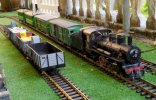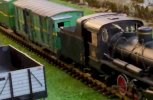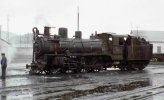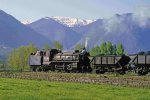Modelling a Spanish railway in G Scale does require a bit of imagination and resourcefulness, as just about everything has to be customised or made from scratch. As far as I know, the only Spanish models ever produced commercially were wooden kits of coaches similar to the ones I've just bashed.
Over the winter season, I've been busy with updating some locos and stock.
The matchboard-sided bogie coach with end balconies is characteristic of almost all Spanish railways in the mid 20th century, both Iberian gauge national, and secondary lines, and so the 'via metrica' Ferrocarril Val de Martyn simply had to have some. This is yours truly posing daftly with a full sized example during a visit to the 'secret' workshops of the Carrilet heritage project at Deltebre in 2014:
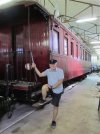
I don't/can't model exact prototypes, so I just like to make things look vaguely plausible based on studying countless old photos on the internet and from my travels. Over a decade ago, I had decided to use brand new three Bachmann Jackson-Sharp carriages as the basis for my 'Correo', the traditional daily all-stations mixed service, which transported the mail as well as people and goods. Good job I bought them a long while back when I was still working and had some cash, though they were to linger in their boxes a very long time before I could muster the courage to butcher them!
Having disassembled my pristine victims, I stripped the nice neat paint with alcohol, hacked off and discarded the clerestories, and made foamboard and ABS frames to bridge the resulting gaps down the centre of each roof.
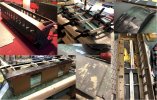
The new roofs were skinned with thin plasticard with a touch of Milliput to smooth the fiddly ends, before aerosol painting and installing resin ventilators (eBay) and gutter strips. Each coach has its own 9V battery. Warm white lighting is LED strips, plus single LEDs for the balconies and baggage car, self-contained in the roof with the necessary boards and resistors, and with the passenger coaches, I utilised the original brass strip connections down the internal sides to the existing battery boxes and switches beneath the frames. For the baggage/mail car, the 9V battery and iffy wiring is tucked inside through one of the doors under a pile of crates and I made my own LED side and tail lamps from odd bits and pieces - an old felt pen and washers and the like. A DPDT switch below allows the rear lamp configuration to be changed, depending in what type of train the van is running: pure goods or passenger/mixed. External steps were added beneath the side doors and I hope they survive some of the tight clearances on my line.

For the interiors, the original seats were covered with homemade transfers to represent the characteristic hard wooden slats, and one coach has had inserted a couple of first-class compartments made from scratch, with GRS seat profiles upholstered with more transfers. The pictures are period correct shots of famous sights around Catalunya. Various repainted cheapo figures from Hong Kong via eBay fill some of the seats.
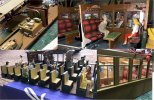
For the exterior, I faced an awkward choice: whether to go for the museum look - varnished hardwood, or instead to spray the bodies a low sheen brown, to represent faded stock that has served a couple of decades under the Spanish sun. I chose the latter, which is more in keeping with my railway, for it is supposed to be late 1960s and the independent line is on its last legs before being taken over by the State and closed.

Lettering ought to be individual brass letters but that's beyond me, so I've used 'shaded' decals. Various other details were added to the balconies, metal wheels fitted, and then the lot was given a gentle weathering. Lesson learnt there is that what looks acceptable on the bench and even in winter daylight can become quite garish in full sun. I'm going to have to revisit some of this and tone it down a bit.
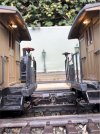
And to complete the train, a BMS 16mm van has been tweaked a bit to provide the customary goods wagon within the consist. It's not fitted with continuous brakes but 'regla ocho' (Rule 8) is the most important regulation on the FVM, so don't look too closely!
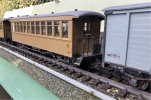
My railway is not yet up and running for the coming season, but I cleaned some track and took the train outside for a few piccies of its first run, headed by my recently re-bashed Big Hauler 4-6-0. In the fictional history of my fictional line, it is about 1967 and the FVM has just acquired a nearly new fancy German diesel to handle the coal trains, re-liveried and fresh out of the loco works at Morella. Faithful old Baldwin old No.3 'Santa Angela' is therefore enjoying an easier life now in its new role on the 'Correo' Service.
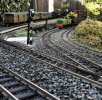
Although far from perfect, I'm rather pleased with the overall result, which I think is recognisably Spanish in flavour.
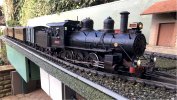
Optional extra half-minute shaky phone video to prove it does all actually move!
Over the winter season, I've been busy with updating some locos and stock.
The matchboard-sided bogie coach with end balconies is characteristic of almost all Spanish railways in the mid 20th century, both Iberian gauge national, and secondary lines, and so the 'via metrica' Ferrocarril Val de Martyn simply had to have some. This is yours truly posing daftly with a full sized example during a visit to the 'secret' workshops of the Carrilet heritage project at Deltebre in 2014:

I don't/can't model exact prototypes, so I just like to make things look vaguely plausible based on studying countless old photos on the internet and from my travels. Over a decade ago, I had decided to use brand new three Bachmann Jackson-Sharp carriages as the basis for my 'Correo', the traditional daily all-stations mixed service, which transported the mail as well as people and goods. Good job I bought them a long while back when I was still working and had some cash, though they were to linger in their boxes a very long time before I could muster the courage to butcher them!
Having disassembled my pristine victims, I stripped the nice neat paint with alcohol, hacked off and discarded the clerestories, and made foamboard and ABS frames to bridge the resulting gaps down the centre of each roof.

The new roofs were skinned with thin plasticard with a touch of Milliput to smooth the fiddly ends, before aerosol painting and installing resin ventilators (eBay) and gutter strips. Each coach has its own 9V battery. Warm white lighting is LED strips, plus single LEDs for the balconies and baggage car, self-contained in the roof with the necessary boards and resistors, and with the passenger coaches, I utilised the original brass strip connections down the internal sides to the existing battery boxes and switches beneath the frames. For the baggage/mail car, the 9V battery and iffy wiring is tucked inside through one of the doors under a pile of crates and I made my own LED side and tail lamps from odd bits and pieces - an old felt pen and washers and the like. A DPDT switch below allows the rear lamp configuration to be changed, depending in what type of train the van is running: pure goods or passenger/mixed. External steps were added beneath the side doors and I hope they survive some of the tight clearances on my line.

For the interiors, the original seats were covered with homemade transfers to represent the characteristic hard wooden slats, and one coach has had inserted a couple of first-class compartments made from scratch, with GRS seat profiles upholstered with more transfers. The pictures are period correct shots of famous sights around Catalunya. Various repainted cheapo figures from Hong Kong via eBay fill some of the seats.

For the exterior, I faced an awkward choice: whether to go for the museum look - varnished hardwood, or instead to spray the bodies a low sheen brown, to represent faded stock that has served a couple of decades under the Spanish sun. I chose the latter, which is more in keeping with my railway, for it is supposed to be late 1960s and the independent line is on its last legs before being taken over by the State and closed.

Lettering ought to be individual brass letters but that's beyond me, so I've used 'shaded' decals. Various other details were added to the balconies, metal wheels fitted, and then the lot was given a gentle weathering. Lesson learnt there is that what looks acceptable on the bench and even in winter daylight can become quite garish in full sun. I'm going to have to revisit some of this and tone it down a bit.

And to complete the train, a BMS 16mm van has been tweaked a bit to provide the customary goods wagon within the consist. It's not fitted with continuous brakes but 'regla ocho' (Rule 8) is the most important regulation on the FVM, so don't look too closely!

My railway is not yet up and running for the coming season, but I cleaned some track and took the train outside for a few piccies of its first run, headed by my recently re-bashed Big Hauler 4-6-0. In the fictional history of my fictional line, it is about 1967 and the FVM has just acquired a nearly new fancy German diesel to handle the coal trains, re-liveried and fresh out of the loco works at Morella. Faithful old Baldwin old No.3 'Santa Angela' is therefore enjoying an easier life now in its new role on the 'Correo' Service.

Although far from perfect, I'm rather pleased with the overall result, which I think is recognisably Spanish in flavour.

Optional extra half-minute shaky phone video to prove it does all actually move!
Attachments
-
12
-
3
- Show all



